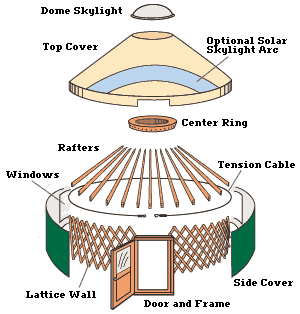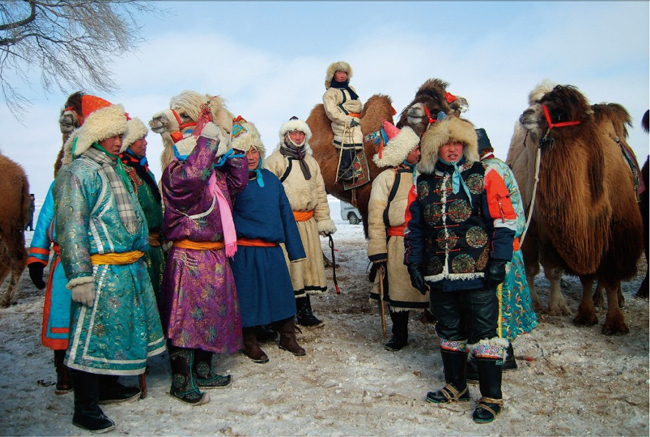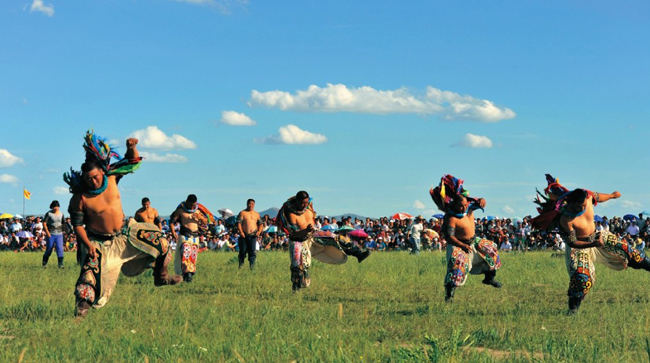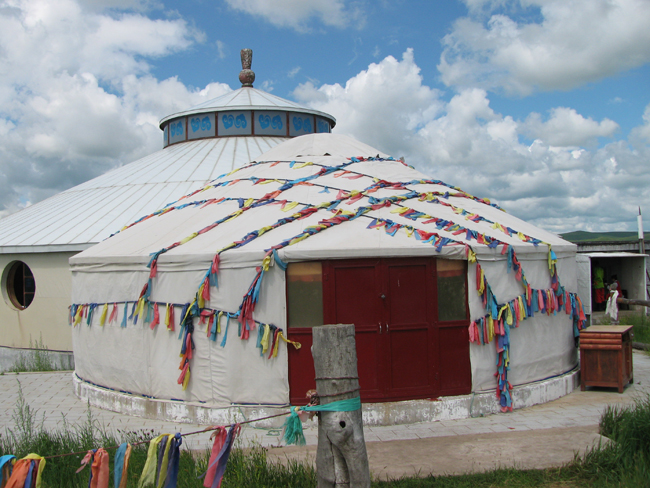Zoom In Zoom Out Mongolia People: Warriors from Northern Grassland
2015-09-04 01:09:41 Author:culture Source:National culture Browse number:131 Comment 0 A
800 years ago, they are the most feared killing machine in the world, the nightmare of Han emperors and the curse for Middle East and European countries. Whenever they go, cities are leveled to the ground and people are enslaved overnight. To shield from their marauding hordes, the construction of The Great Wall began as early as Spring and Autumn Period (770BC-221BC) and lasted for several thousands of years, but all in vain.
The combination of overwhelming military forces, strong determination and unexpected attacking tactics have resulted in many triumphs and legacies which outshine any military general ever lived. Even Mac Authur and Napoleon were impressed by their effective attacks and thorough plans and deemed them as unraveled and invincible soldiers.
The empire they built spanned the majority of the north hemisphere, extending all the way from the pacific ocean of Baltic Sea horizontally, from Siberia to Persian Gulf vertically. For the first time of history, east and west bumped into each other fiercely and trade prospered with unprecedented scale and meteoric speed. Under their law, a defenseless girl with a pack of gold can stroll along this great empire spanning 50 longitudes safely, not alone those merchants, missionaries and soldiers. Through this artery, frequent, in-depth and lasting cultural and economy exchange has become a defining scene. In this time, Marco Polo got acquaintance with Sakyamuni, Persian painters were fascinated by traditional Chinese painting and Beijing saw the penetration of Catholicism.
They are the Mongolian people, who are born warriors, archers and horse riders. Hailing from northern China, these least educated “barbarians” once smashed the old world, created a new one and governed it with law and order.
In this essay, I will lead you walk into their world which is still steeped in mysticism.
Mongolians are born in the saddle and at the core of their culture is horse racing. Millennia’s time spent on rolling grassland has cultivated another enlightened culture, which presents a sharp contrast to the rest of China. Naadam Festival celebrated each July to August is a perfect time for outsiders to sample their vibrant life embodied by archery, horse racing and wrestling. While the euphonious Khoomei(throat-sing) which breaks the eternal tranquility overhanging the grassland, reveals their romantic side. Because of its immeasurable value, throat singing, the enchanting voice from grassland has been included into UNESCO Intangible Heritage Site.
When visit Mongolia, one of the highlights of the agenda is to stay in a yurt, which can be erected in half a hour as well as be carried away at any time.
Yurt is a fine example of practical usage and aesthetic beauty. These white “mushrooms” dotting along the rolling grasslands have a history dating back to Genghis Kan’s era. It spits into two categories; the stationary yurts and the portable yurts. Cheap and simple materials including wooden pillars, woolen, furs and ropes are used to build them. Guided by time-weathered methods, these yurts can survive gales, sandstorms, extreme weather and the weight of snow and rain. Yurts have many advantages: it is cool in summer and warm in winter. It is well-lighted and spacious. It is easy to build and move. As a result, it is perfect for nomadic life.
dating back to Genghis Kan’s era. It spits into two categories; the stationary yurts and the portable yurts. Cheap and simple materials including wooden pillars, woolen, furs and ropes are used to build them. Guided by time-weathered methods, these yurts can survive gales, sandstorms, extreme weather and the weight of snow and rain. Yurts have many advantages: it is cool in summer and warm in winter. It is well-lighted and spacious. It is easy to build and move. As a result, it is perfect for nomadic life.
From choosing a location to refurnishing its interior, building a yurt is art. The white color is adopted to reflect the scorching sun during summer and ensure coolness inside. Its round dome ensures super protection against 10-level gale, windstorm, rain and snow. Pillars are erected to support huge weight. Over the past hundreds of years, the Mongolians have mastered the skills so good that you can seldom hear the collapse of a yurt.
The size of yurts varies from accommodating 20 to over 2000 people. Its layout is settled, which obeys the tradition. Man’s items are put in the north, northwest, west and southwest quarters, while the rest space is occupied by women. This practice reflects the different labor allocation between both gender and living habit, rather than originate from the outdated feudal concept.
North: it is placed with an eight-leg table for sheltering quits. Covered with exquisite rugs, this table is a must-have for any newly-wedded son. The collar opening of the robes must head toward the Buddha. Men’s clothes are put above women’s. It is a taboo to put the neck opening towards the door, for this is a practice reserved for the deceased.
Northwest: the holy area reserved for Buddha. Sheltered within shrines and niches, Buddha statues are carefully locked. During various religious festivals, the Mongolians will light up candles and prepare offerings to pray for wealth and longevity.
West: designated as men’s privileged kingdom, this area is used to house guns, knives, saddles and wrestling gears. When you are in a yurt, it is a taboo to trample on or step across the saddles. This reflects their deep-rooted reverence for horse.
Southwest: yogurt tanks and saddles.
Northeast: it is used to house women’s cases containing clothes and jewelry.
East: place for dish rack. For the sake of sanitary, food, meat and fruits are arranged into tiers. Tea and milk are put above the rest. The most treasured item in the home is milk barren. Bowls, spoons and shovels are not allowed to put upside down.
Southeast: Compared to other quarters, this area is designated for more flexible uses. In spring, the Mongolian put water buckets and dried cow dung here. It is also used as a temporary refugee for a newly-born calf. During summer and autumn, a yogurt tank is added, and a clay kitchen is erected to make milk products.
East: dog’s dining groove.
When you are exploring the yurt, remember do not go across the box containing cow dung. In a single rule, do not go across anything related to fire.
The combination of overwhelming military forces, strong determination and unexpected attacking tactics have resulted in many triumphs and legacies which outshine any military general ever lived. Even Mac Authur and Napoleon were impressed by their effective attacks and thorough plans and deemed them as unraveled and invincible soldiers.
The empire they built spanned the majority of the north hemisphere, extending all the way from the pacific ocean of Baltic Sea horizontally, from Siberia to Persian Gulf vertically. For the first time of history, east and west bumped into each other fiercely and trade prospered with unprecedented scale and meteoric speed. Under their law, a defenseless girl with a pack of gold can stroll along this great empire spanning 50 longitudes safely, not alone those merchants, missionaries and soldiers. Through this artery, frequent, in-depth and lasting cultural and economy exchange has become a defining scene. In this time, Marco Polo got acquaintance with Sakyamuni, Persian painters were fascinated by traditional Chinese painting and Beijing saw the penetration of Catholicism.
They are the Mongolian people, who are born warriors, archers and horse riders. Hailing from northern China, these least educated “barbarians” once smashed the old world, created a new one and governed it with law and order.
 |
In this essay, I will lead you walk into their world which is still steeped in mysticism.
Mongolians are born in the saddle and at the core of their culture is horse racing. Millennia’s time spent on rolling grassland has cultivated another enlightened culture, which presents a sharp contrast to the rest of China. Naadam Festival celebrated each July to August is a perfect time for outsiders to sample their vibrant life embodied by archery, horse racing and wrestling. While the euphonious Khoomei(throat-sing) which breaks the eternal tranquility overhanging the grassland, reveals their romantic side. Because of its immeasurable value, throat singing, the enchanting voice from grassland has been included into UNESCO Intangible Heritage Site.
 |
| Naadam Festival |
Yurt: the moving castle of Mongolian
When visit Mongolia, one of the highlights of the agenda is to stay in a yurt, which can be erected in half a hour as well as be carried away at any time.
Yurt is a fine example of practical usage and aesthetic beauty. These white “mushrooms” dotting along the rolling grasslands have a history
 dating back to Genghis Kan’s era. It spits into two categories; the stationary yurts and the portable yurts. Cheap and simple materials including wooden pillars, woolen, furs and ropes are used to build them. Guided by time-weathered methods, these yurts can survive gales, sandstorms, extreme weather and the weight of snow and rain. Yurts have many advantages: it is cool in summer and warm in winter. It is well-lighted and spacious. It is easy to build and move. As a result, it is perfect for nomadic life.
dating back to Genghis Kan’s era. It spits into two categories; the stationary yurts and the portable yurts. Cheap and simple materials including wooden pillars, woolen, furs and ropes are used to build them. Guided by time-weathered methods, these yurts can survive gales, sandstorms, extreme weather and the weight of snow and rain. Yurts have many advantages: it is cool in summer and warm in winter. It is well-lighted and spacious. It is easy to build and move. As a result, it is perfect for nomadic life. From choosing a location to refurnishing its interior, building a yurt is art. The white color is adopted to reflect the scorching sun during summer and ensure coolness inside. Its round dome ensures super protection against 10-level gale, windstorm, rain and snow. Pillars are erected to support huge weight. Over the past hundreds of years, the Mongolians have mastered the skills so good that you can seldom hear the collapse of a yurt.
The size of yurts varies from accommodating 20 to over 2000 people. Its layout is settled, which obeys the tradition. Man’s items are put in the north, northwest, west and southwest quarters, while the rest space is occupied by women. This practice reflects the different labor allocation between both gender and living habit, rather than originate from the outdated feudal concept.
North: it is placed with an eight-leg table for sheltering quits. Covered with exquisite rugs, this table is a must-have for any newly-wedded son. The collar opening of the robes must head toward the Buddha. Men’s clothes are put above women’s. It is a taboo to put the neck opening towards the door, for this is a practice reserved for the deceased.
Northwest: the holy area reserved for Buddha. Sheltered within shrines and niches, Buddha statues are carefully locked. During various religious festivals, the Mongolians will light up candles and prepare offerings to pray for wealth and longevity.
West: designated as men’s privileged kingdom, this area is used to house guns, knives, saddles and wrestling gears. When you are in a yurt, it is a taboo to trample on or step across the saddles. This reflects their deep-rooted reverence for horse.
 |
Southwest: yogurt tanks and saddles.
Northeast: it is used to house women’s cases containing clothes and jewelry.
East: place for dish rack. For the sake of sanitary, food, meat and fruits are arranged into tiers. Tea and milk are put above the rest. The most treasured item in the home is milk barren. Bowls, spoons and shovels are not allowed to put upside down.
Southeast: Compared to other quarters, this area is designated for more flexible uses. In spring, the Mongolian put water buckets and dried cow dung here. It is also used as a temporary refugee for a newly-born calf. During summer and autumn, a yogurt tank is added, and a clay kitchen is erected to make milk products.
East: dog’s dining groove.
When you are exploring the yurt, remember do not go across the box containing cow dung. In a single rule, do not go across anything related to fire.
On A: Tibetan Nationality
Next article: Yao People Introduction
Already existing0Comment
Review all comments>>














